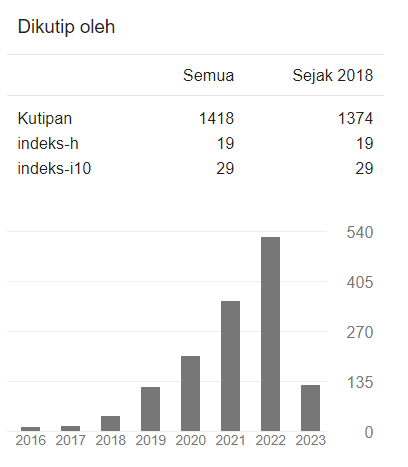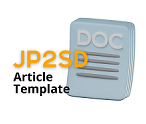Pengembangan Media JESSTAR Sebagai Media Pembelajaran Tematik Tema 9 Kelas VI SD
DOI:
https://doi.org/10.22219/jp2sd.v10i1.20476Abstract
The implementation of learning in elementary schools applies thematic learning. Nevertheless, in reality, the learning process has not run optimally. It is because linkages among materials are not optimal, and there is no particular learning media for thematic learning. One of the efforts to optimize thematic learning is to develop thematic learning media. This study aims to develop JESSTAR media for thematic learning of theme 9 grade VI SD and test the learning media's feasibility. This study is developmental research in the field of education. JESSTAR media development uses the ADDIE development model (analysis, design, development, implementation, evaluation). The study was carried out at SD Negeri 1 Asahduren. The data collection method used is observation, questionnaire, and interview. The data analyzed in this research is a descriptive qualitative analysis to process data from the result of expert review and a quantitative descriptive analysis to process data on product validity and practicality test as indicators of media feasibility. The validity test results of media experts, material experts, and learning designs obtained the percentage level of validity of 95.00%, 90.67%, and 96.00%, respectively. If it is converted, then everything is in the excellent category. The results of the practicality test for teachers, small group trial, and large group trial obtained the percentage practicality level of 92.38%, 94,83%, and 93.73% respectively. If it is converted, then everything is in the excellent category. Based on the results of validity tests by experts and results of practicality tests by practitioners (teachers) and students, it can be seen that JESSTAR media is in the excellent category. Thus, it can be concluded that the JESSTAR media is suitable for use as a learning media for theme 9 in grade VI elementary schools
Downloads
References
Afandi, R. (2015). Pengembangan Media Pembelajaran Permainan Ular Tangga Untuk Meningkatkan Motivasi Belajar Siswa dan Hasil Belajar IPS Di Sekolah Dasar. JINoP (Jurnal Inovasi Pembelajaran), 1(1), 77–89.
Agung, A. A. G. A. (2014). Buku Ajar Metodologi Penelitian Pendidikan. Aditya Media Publishing.
Arfandi. (2020). Pemanfaatan Media Pembelajaran Dalam Meningkatkan Kualitas Pembelajaran PAI Di Sekolah. Edupedia, 5(1), 65–77.
Ariya, M., & Whindi Arini, N. (2021). Media Monopoli Sains (MONOIN) Untuk Pembelajaran IPA Pada Materi Semester I Kelas IV. Mimbar PGSD Undiksha, 9(2), 268–275. https://ejournal.undiksha.ac.id/index.php/JJPGSD
Bujuri, D. A. (2018). Analisis Perkembangan Kognitif Anak Usia Dasar dan Implikasinya dalam Kegiatan Belajar Mengajar. Literasi, IX(1), 37–50. www.ejournal.almaata.ac.id/literasi
Darmawan, D. & K. C. (2020). Pengembangan Media Pembelajaran : Konsep dan Aplikasi Pengembangan Media Pembelajaran Bagi Pendidikan Di Sekolah dan Masyarakat. Kencana.
Fahri, L. M., & Qusyairi, L. A. H. (2019). Interaksi Sosial Dalam Proses Pembelajaran. PALAPA : Jurnal Studi Keislaman Dan Ilmu Pendidikan, 7(1), 149–166. http://ejournal.undiksha.ac.id/index.php/JJPGSD/article/view/1390
Ferawati Jafar, A., & Mardia, A. (2017). Efektifitas Penggunaan Media Pembelajaran Monopoly Game Smart Terhadap Minat Belajar Peserta Didik. Jurnal Pendidikan Fisika, 5(1), 19–25. http://journal.uin-alauddin.ac.id/indeks.php/PendidikanFisika
Indriani, D. S. (2014). Keefektifan Model Think Pair Share Terhadap Aktivitas dan Hasil Belajar IPS. Journal of Elementary Education, 3(2), 21–27. http://journal.unnes.ac.id/sju/index.php/jee
Kadi, T., Samarinda, I., Timur, K., & Awwaliyah, R. (2017). Inovasi Pendidikan : Upaya Penyelesaian Problematika Pendidikan Di Indonesia. Jurnal Islam Nusantara, 01(02), 144–155.
Lestari, E. (2020). Pendekatan Saintifik di Sekolah Dasar. CV Budi Utama.
Mulyatiningsih, E. (2012). Metode Penelitian Terapan Bidang Pendidikan. Alfabeta.
Mustofa, A. H. , dkk. (2020). Media Pembelajaran. Yayasan Kita menulis.
Novita, L., Sundari, F. S., & Rabani, K. R. (2020). Penerapan Media Game Ular Tangga Digital untuk Meningkatkan Hasil Belajar Tematik. Jurnal Pemikiran Dan Pengembangan Sekolah Dasar (JP2SD), 8(2), 126–137. https://doi.org/10.22219/jp2sd.v8i2.12329
Nurpratiwiningsih, L., & Didik, T. S. (2018). Development of Education Games Map Material as a Learning Media for Elementary School Students. Journal of Primary Education, 8(3), 249–257. https://doi.org/10.15294/jpe.v8i3.26251
Okdiansyah, O., Satria, T. G., & Aswarliansyah, A. (2021). Pengembangan Media Pembelajaran Flashcard Pada Pembelajaran Tematik Kelas IV SD Negeri 4 Srikaton. Edu Cendikia: Jurnal Ilmiah Kependidikan, 1(3), 148–154. https://doi.org/10.47709/educendikia.v1i3.1183
Retnawati, H. (2016). Analisis Kuantitatif Instrumen Penelitian. Parama Publishing.
Rohanah, L., Mirawati, M., & Anwar, W. S. (2020). Pengaruh Interaksi Sosial Terhadap Aktivitas Belajar Peserta Didik. Jurnal Pendidikan Dan Pengajaran Guru Sekolah Dasar (JPPGuseda), 03, 139–143. http://journal.unpak.ac.id/index.php/jppguseda
Sahara, D. (2017). Pengaruh Metode Learning By Games Terhadap Hasil Belajar Matematika Peserta Didik Kelas III MIN 10 Bandar Lampung.
Santika, M., & Dasar, P. (2019). Peningkatan Efektivitas Berkomunikasi Dan Hasil Belajar Siswa Kelas IV SD Pada Pembelajaran IPA Melalui Model Open Ended. Jurnal Pemikiran Dan Pengembangan Sekolah Dasar, 7(1), 30–37. http://ejournal.umm.ac.id/index.php/jp2sd
Sapriyah. (2019). Media Pembelajaran Dalam Proses Belajar Mengajar. Prosiding Seminar Nasional Pendidikan FKIP, 2(1), 470–477.
Setyosari, P. (2016). Metode Penelitian dan Pengembangan. Kencana Prenada Media Group.
Sezer, B., Yilmaz, F. G. K., & Yilmaz. R. (2013). Integrating Technology Into Classroom: The Learner-Centered Instructional Design. International Journal on New Trends in Education and Their Implications, 4(4), 134–144. www.ijonte.org
Suardipa, I. P. (2018). Guru Sebagai Agen Inovator Berbasis Higherorder Thinking Skills. Purwadita, 2(2), 73–83.
Supriyono. (2018). Pentingnya Media Pembelajaran Untuk Meningkatkan Minat Belajar Siswa SD. Edustream : Jurnal Pendidikan Dasar, 2(1), 43–48.
Utomo, E. S. (2017). Peningkatan Prestasi Belajar Siswa Menggunakan Mulitimedia Pembelajaran Sistem Tata Surya Pada Mata Pelajaran Ilmu Pengetahuan Alam Kelas VI di SD Negeri Puren Sleman. E-Journal Prodi Teknologi Pendidikan, 6(7), 666–672.
Widiyati, W. (2014). Belajar dan Pembelajaran Perspektif Teori Kognitivisme. Jurnal Biology Science & Education, 3(2), 177–187.
Worowirastri, D., Wahyu, I., & Ika, D. (2018). Analisis Penggunaan Media Pembelajaran Tematik Di SD Muhammadiyah 9 Kota Malang. JINoP (Jurnal Inovasi Pembelajaran), 4(1), 17–25. http://ejournal.umm.ac.id/index.php/jinop
Yestiani, D. K., & Zahwa, N. (2020). Peran Guru Dalam Pembelajaran Pada Siswa Sekolah Dasar. Jurnal Pendidikan Dasar, 4(1), 41–47. https://ejournal.stitpn.ac.id/index.php/fondatia
Downloads
Published
Issue
Section
License
Copyright (c) 2022 Jurnal Pemikiran dan Pengembangan Sekolah Dasar (JP2SD)

This work is licensed under a Creative Commons Attribution-ShareAlike 4.0 International License.
Authors who publish with Jurnal Pemikiran dan Pengembangan Sekolah Dasar (JP2SD) agree to the following terms:
- For all articles published in Jurnal Pemikiran dan Pengembangan Sekolah Dasar (JP2SD), copyright is retained by the authors. Authors give permission to the publisher to announce the work with conditions. When the manuscript is accepted for publication, the authors agree to automatic transfer of the publishing right to the publisher.
- Authors retain copyright and grant the journal right of first publication with the work simultaneously licensed under a Creative Commons Attribution-ShareAlike 4.0 International License that allows others to share the work with an acknowledgment of the work's authorship and initial publication in this journal.
- Authors are able to enter into separate, additional contractual arrangements for the non-exclusive distribution of the journal's published version of the work (e.g., post it to an institutional repository or publish it in a book), with an acknowledgment of its initial publication in this journal.
- Authors are permitted and encouraged to post their work online (e.g., in institutional repositories or on their website) prior to and during the submission process, as it can lead to productive exchanges, as well as earlier and greater citation of published work (See The Effect of Open Access).

This work is licensed under a Creative Commons Attribution-ShareAlike 4.0 International License.


















